Omphaloskepsis Blog
Surface and sensuality, its like stroking pussy willows.
Mar 10, 2011
 Cecily Brown
Cecily Brown
Deleuze wrote about the difference between figuration and figurative in this way:
“Painting has to extract the Figure from the figurative [...] modern painting has a different relation to figuration or illustration than the painting of the past. [...] painting used to be conditioned by certain “religious possibilities” that still gave a pictorial meaning to figuration, whereas modern painting is an atheistic game.” He adds: “[...] modern painting is invaded and besieged by photographs and clichés that are already lodged on the canvas before the painter even begins to work. In fact, it wold be a mistake to think that the painter works on a white and virgin surface. The entire surface is already invested virtually with all kinds of clichés, which the painter will have to break with. This is exactly what Bacon says when he speak of the photograph: is it not a figuration of what one sees, it is what modern man sees. It is not dangerous simply because it is figurative, but because it claims to reign over vision, and thus to reign over painting. Having renounced the religious sentiment, but besieged by the photograph, modern painting finds itself in a situation that, despite appearances, makes it much more difficult to break with the figuration that would seem to be its miserable reserved domain.
What is he talking about?– he’s talking about “freeing the Figure from figuration.” Figurative v. figural. Painting v. illustration.
And THAT is where my current struggle lies as I continue to work on Mi Madre. Perhaps it would be more fitting to nickname it lágrimas desiertas. As I work from my photograph, I find I am getting caught up in the illustrative, having already been stuck in the stereotyping of the image. So, I think I must examine surface, since I have image, concept, and composition.
Here are some painters who handle surface powerfully:

Mark Tansy: 2009 Tree
Although this may look simple, Tansy only paints 1-3 large scale paintings per year. He works a great deal by erasing. Recently I saw his work at Gagosian midtown.
“I think of the painted image as summarizing the problem we face when confronted with reality. The question we need to ask ourselves is: Which reality? The reality represented in a painted image? The reality of the flat image, or the multi-dimensional reality that exists between the viewer and the artist?” This question about the image and how it is exploited,?testing the limits of representation, is at the heart of Mark Tansey’s work. Tansey, who lives and works in New York, was born in San José in 1949.
With two art historians for parents, he is acutely aware of the history of art. He produces monumental, and decidedly ambiguous, monochrome paintings: in their extremely precise detail they have the feel of documentary photography, yet at the same time they depict impossible situations. This paradox gives Tansey’s work a special resonance that challenges our perception. What initially seems recognizable turns out to be an allegorical visual construction, manipulating the conventions and structures of figurative painting. He uses?irony and Surrealistic combinations of places and historical figures to establish strange connections between ideas and events. His narratives never actually take place – quite the opposite; his work studies how various types of reality interact and may merge, going beyond the reality / fiction dichotomy he considers obsolete.
http://www.annualartmagazine.com/mark-tansey/

Jenny Saville. She’s fearless. Look what she does in oils with her mark-making, look at the brushwork. the paint almost looks like clay.
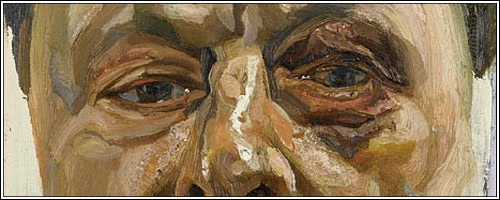
Lucian Freud, detail from one of his paintings.

Van Gogh, House in Auvers. There is no way to reproduce in books, photography, web, a Van Gogh painting. You just have to see them in person. Nothing can capture the marks, the surface, the vibrancy, the energy, the essence, the emanations coming from the art to you and back again, charging the held space between the two of you. Yet, here I show it to you, as a place holder.

Cecily Brown
This painting is from a later series in which fragmented body parts have been totally consumed by the painterly surface. These paintings have been described by art critic Roberta Smith as “… an attempt to juice up and feminize the shop worn vocabulary of abstract expressionism.” The titles that Brown chooses are often taken from Hollywood movies. In this case, the title is taken from the 1950 classic, Father of the Bride. References to brides,
When David Sylvester and his friend Francis Bacon took Cecily Brown to exhibitions as a girl, she had no idea the art critic was actually her father( David Sylvester, one of Britain's leading art critics ). Now one of the most collectable painters in the world, she is quick to acknowledge the influence of both.
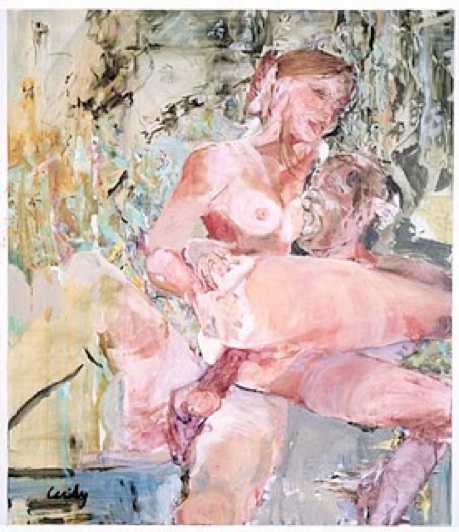
Cecily Brown’s luscious paintings combine figuration and abstraction. Expanding the tradition of expressionism, she draws her influences from painters such as Francis Bacon and Willem de Kooning to put a feminine twist on a male dominated art history.
She has since established herself as one of the key figures in the strong resurgence of painting at the end of the nineties. Brown revels in the freedom she has forged as a young female painter, her work liberates and celebrates the sacred cows of old master figure painting.
Cecily Brown uses paint with an unusual sensuality, her creamy layers and rapturous colours offer sexually charged surfaces in which suggestions of figures emerge. Her paintings are marked by a carnal physicality, in which bodies are fragmented, distorted, and fetishised, and paint becomes a malleable and voluptuous substitute for flesh itself.

Brown’s tones and textures range from teasing frivolity, to the sordid and sweltry. Her work offers a distinctively womanly seduction, imparted with a stylised innocence of a bygone era, where illicit romance and passion are discretely veiled within cultivated codes of social etiquette and decadent fashion.
http://veneraaa.blogspot.com/2008/05/artist-cecily-brown.html
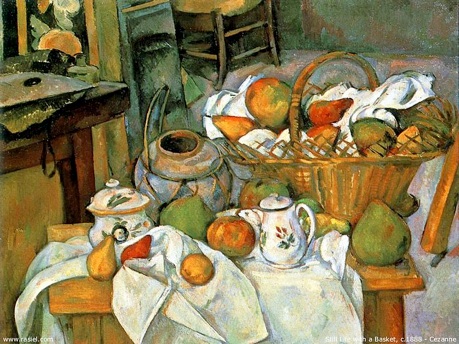
Paul Cezanne, Still Life with Basket

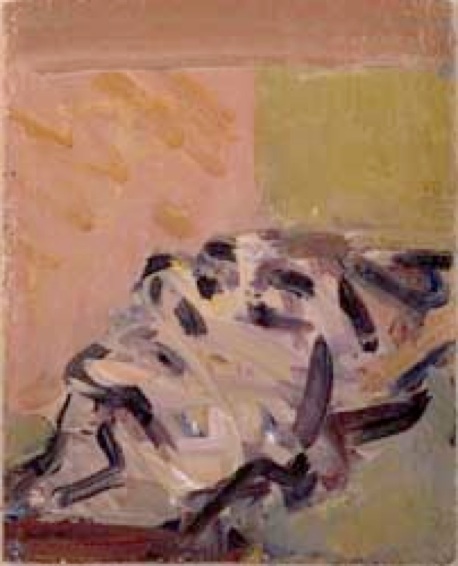
Frank Auerbach, Top: Head of Paula Eyles, Bottom Julia

John Singer-Sargent, Dancer. This painting is in the Isabella Stewart Gardner Museum in Boston. I could sit in front of it for hours. yum!
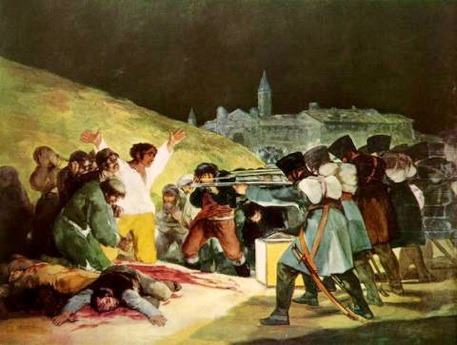
Goya, 3rd of May 1808, one of the all time greatest war paintings.

Martin Kippenberger, Stammheim. Kippenberger taught us that an artist did not have to stick to any one style of painting or oeuvre of art. Yeah!

Dana Schutz, Gravity Fanatic. These paintings are huge and she just loads it on. Again, courageous with the paint. There’s surface and content. Sensuality. Free.
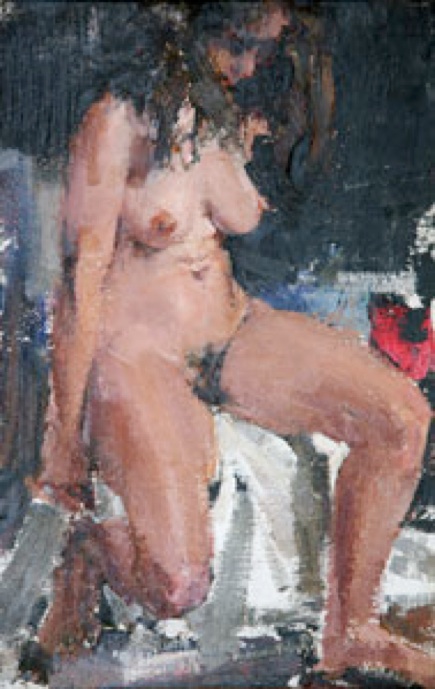
Nicolai Fechin, seated nude
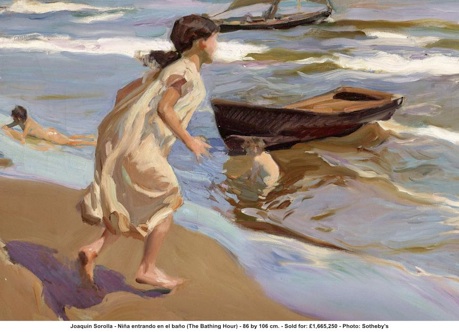
Sorollas, The bathing hour. This I think of more of an illustration, yet look at the mark-making. Yet, look at all the colors in the water.

And here’s a close up of where I am, as I pull the paint across the canvas. I can where I need to go. The first painting in this series was Fearless. There are ways of seeing, things I love, about working from life. Working like this has its tricks and traps. I need to take from it what is good –here it looks like water is turning to fire–and apply what is visceral. All the while I remember the neurological element or intent of the work–to hear the painting and activate the polysensory nature of the brain–it’s a balancing act. I can find that “uncanny valley,” the place where the brain accepts what it sees. Right now I feel stuck in figuration.
 MENU
MENU